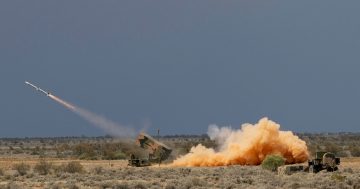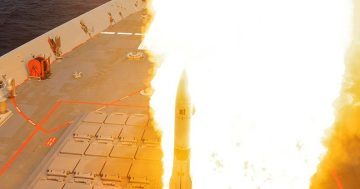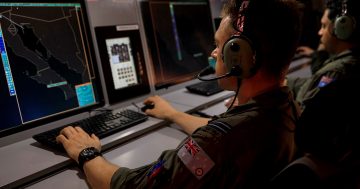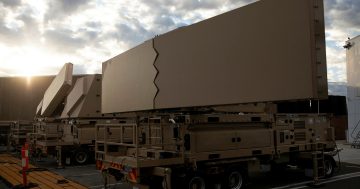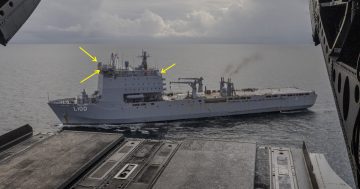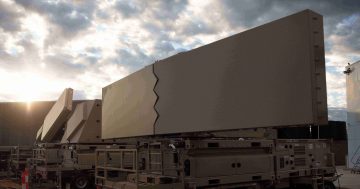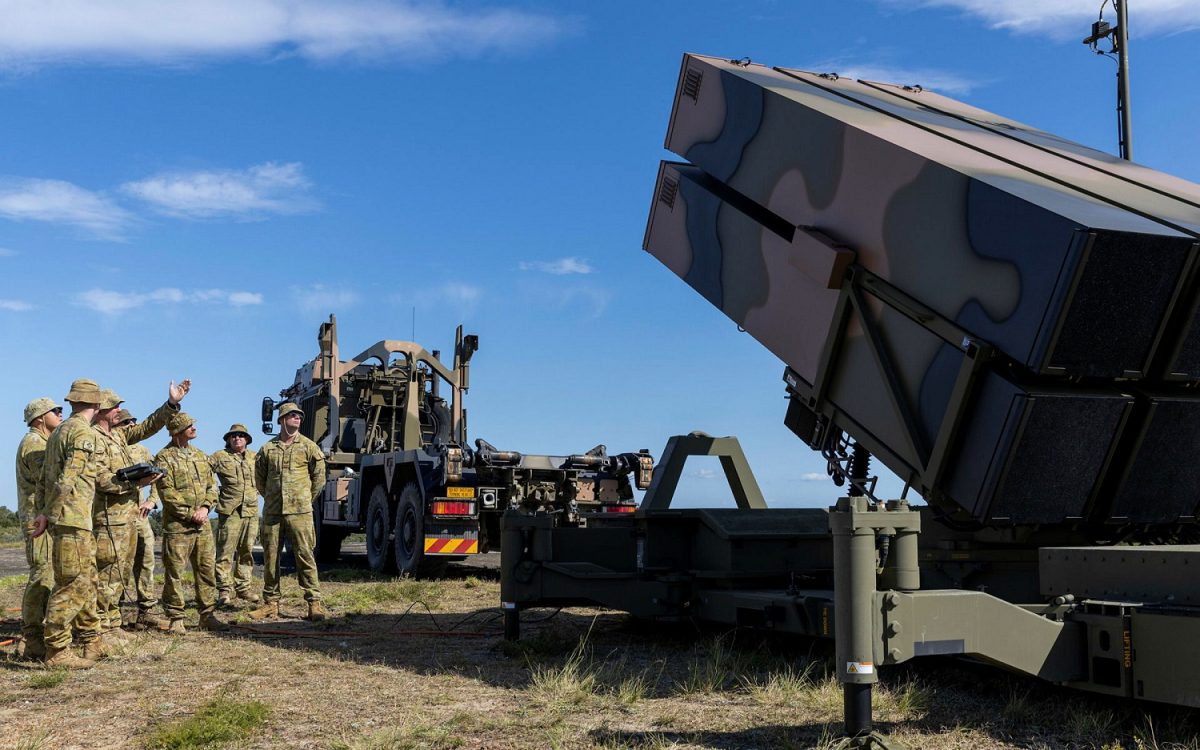
Australian army soldiers get their first look at a deployed E-NASAMS Mk.2 cannister and its HX77 carrier at Jervis Bay in late April. Photos: ADF.
The Australian Army got its first detailed look at its new short-range ground-based air defence (SRGBAD) system during a visit to the Shoalhaven region in late April.
The Enhanced NASAMS (National Advanced Surface-to-Air Missile System) is being acquired for the Army through its Project LAND 19 Phase 7B requirement.
Based on the joint Norwegian-US system designed by Kongsberg and Raytheon, the Enhanced NASAMS system features a large number of Australian-designed and manufactured developments and improvements.
The new system is being integrated at Raytheon Australia’s new Centre for Joint Integration in Adelaide and will be operated by the Army’s 16th Regiment Royal Australian Artillery, which will be based in Edinburgh, north of Adelaide.
Canberra-based Kongsberg Defence Australia is the main sub-contractor to Raytheon, and it has drawn on several Australian companies including Redarc Electronics, Eyelex, Daronmont Technologies, Milspec Manufacturing, Defence Coating Systems, and Zenith for the manufacture and sustainment of the system in service.
Key among the uniquely Australian capabilities is the use of two types of advanced radar arrays developed by Canberra-based CEA Technologies. The CEATAC and CEAOPS arrays will be mounted on Thales Hawkei PMVs and trailers, and Rheinmetall HX77 vehicles respectively. Another Australian addition is the incorporation of an electro-optical MTS-B sensor, which will be mounted on a telescopic pole.
The E-NASAMS’ main weapons, or ‘effectors’ will be AIM-120C AMRAAM radar-guided and AIM-9X infrared-guided missiles, the same as those carried by RAAF and other nations’ air combat aircraft. The much longer-range AMRAAM-ER (Extended Range) has also been successfully tested from NASAMS systems in Norway, and is likely under consideration by Australia.
The AMRAAMs will be cued by the CEATAC and CEAOPS radars, while the AIM-9X can be cued by the radars, the MTS-B, or can be fired manually in the general direction of a threat before homing in on a hot exhaust or aerodynamically heated airframe. While the missile ranges are classified, an air defence bubble of at least 40km in diameter can be maintained.
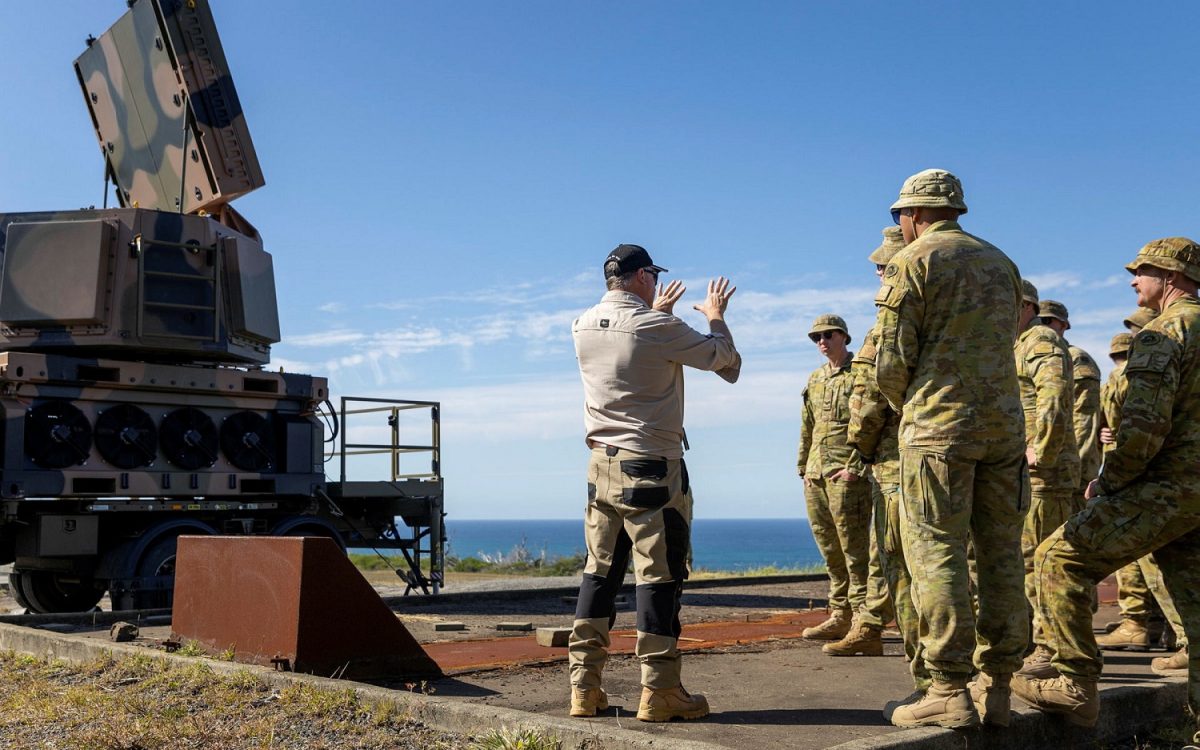
Army instructors demonstrating the E-NASAMS battery with the CEA Technologies CEAOPS radar at left.
A typical E-NASAMS battery will comprise a Hawkei with a vehicle or trailer-mounted CEATAC array, an HX77 with a larger CEAOPS array, a Hawkei with the telescopic MTS-B, an HX40 truck with an Australian-built two-place fire distribution centre, and an HX40 with a Mk.2 cannister launcher. Additional HX40s with spare cannister launchers may also be added.
All of the equipment is highly mobile and can quickly ‘shoot and scoot’ to avoid detection or counter-fires.
“We’ve been waiting for NASAMS for quite some time, so it’s good to finally see the equipment and get it going,” Lance-Bombardier Mitchell North of 110th Battery said in a 9 May Army release after viewing the equipment at Jervis Bay range in April.
“I’m really looking forward to seeing the first missile live fire, but even just doing the tests, getting it slewing and opening the missile-bay doors was really cool to watch.”
Commander 110th Battery Major Brett Watson added, “The introduction into service of NASAMS represents a step change in ground-based air defence capability for the ADF, providing the ability to sense and effect at much greater ranges with state-of-the-art equipment.”
Until now, the Army only had a shoulder or tripod-launch anti-aircraft missile system with a range of about 10 km.
“The whole team is very excited about this journey,” he added. “This familiarisation activity is about allowing those conducting the initial training to learn more about the equipment and interact with the CASG (Defence’s Capability Acquisition and Sustainment Group) and Defence Industry teams – it was a very valuable trip.”
The E-NASAMS system will become the first element of the ADF’s larger Project AIR 6500 Integrated Air and Missile Defence (IAMD) system when it becomes operational later this decade.
That system will comprise the AIR 6500 Phase 1 Joint Air Battle Management System (JABMS) for which CEA Technologies is also providing the main sensor arrays and Lockheed Martin Australia and Northrop Grumman Australia are competing to be the prime system integrator.
Other IAMD elements will include the AIR 6502 medium-range ground-based air defence system (MRGBAD), and the nascent AIR 6503 Phase 1 Advanced High Speed Missile Defence (AHSMD) requirement to defend against ballistic and manoeuvring hypersonic missiles.
The acquisition of E-NASAMS pre-dates the government’s aspirations to manufacture advanced weapons in Australia under the Sovereign Guided Weapons and Explosive Ordnance Enterprise (GWEO), but it is likely the AMRAAM is one of the target missiles the government would hope to build here in the future.











